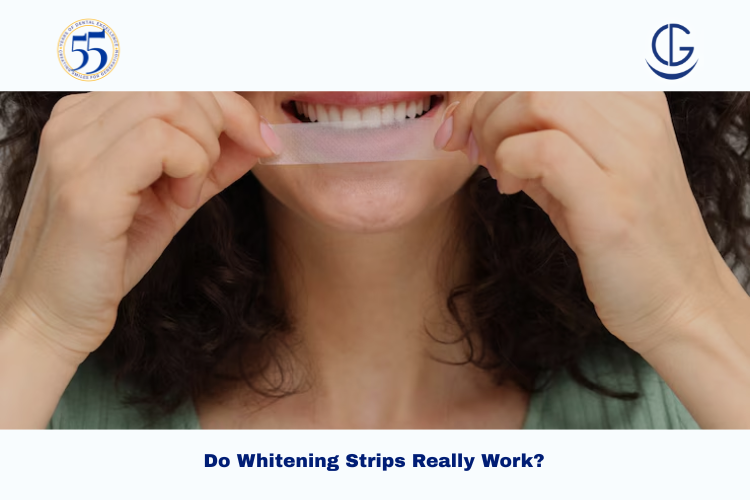Schedule Appointment




Looking for a brighter, whiter smile without visiting the dentist? Teeth whitening strips are one of the most popular solutions for at-home teeth whitening. At Dr. Gowds Dental Hospital, we understand the growing demand for safe, effective, and affordable ways to achieve a dazzling smile. In this guide, we break down how teeth whitening strips work, how to use them, and what kind of results you can expect.
Teeth whitening strips are thin, flexible plastic strips coated with a peroxide-based or non-peroxide whitening gel. They adhere to the surface of your teeth and are designed to remove tooth stains and discoloration caused by coffee, wine, tobacco, and aging.
These strips are a staple in at-home teeth whitening kits and are widely praised for their convenience and affordability compared to in-office treatments.
Most teeth whitening strips use hydrogen peroxide or carbamide peroxide to penetrate the enamel and break down stains at a molecular level. Some natural teeth whitening strips use baking soda, charcoal, or coconut oil for a more holistic approach.
Here’s a step-by-step of how they work:
These products vary in strength, and it’s important to choose an option that suits your sensitivity level and desired results.
If you’re wondering how to use teeth whitening strips, follow these general steps:
How long to leave whitening strips on depends on the brand—always follow the instructions provided. Leaving them on for too long can increase tooth sensitivity.
Many users report noticeable changes in as little as 3–5 days. Full results typically appear after 10–14 days of consistent use. Be sure to look up teeth whitening strips before and after photos for realistic expectations.
| Day | Expected Result |
| Day 1–3 | Slight brightness, minor stain reduction |
| Day 4–7 | Noticeable whitening, better tooth shade |
| Day 8–14 | Significant improvement, even whitening |
| After Day 14 | Maintenance use, minimal staining |
Many worry about whether teeth whitening strips are safe for enamel. The answer? Most are, if used correctly.
Look for products labeled “enamel-safe” or those approved by dental associations. Avoid overusing or using high-concentration peroxide strips without supervision, especially if you have sensitive teeth or pre-existing dental issues.
If you prefer teeth whitening strips without peroxide, there are options that use:
These are considered non-toxic whitening options and may be better for those with sensitive teeth or allergies.
General guidelines suggest:
If you’re asking how often should you use teeth whitening strips, always prioritize what the brand recommends, and consult your dentist for tailored advice.
For coffee lovers, teeth staining is a common issue. The best whitening strips for coffee stains typically contain hydrogen peroxide and have extended wear time. Look for products specifically formulated for tooth stain removal and pair them with a good oral care routine to prevent re-staining.
Wondering whether to go DIY or store-bought?
| DIY Whitening Strips | Store-Bought Whitening Strips |
| Made with natural ingredients | Scientifically tested |
| Cost-effective | Faster, more reliable results |
| May lack consistency | Regulated and often enamel-safe |
| Can be messy or less effective | Convenient and proven |
While DIY tooth whitening strips are appealing, they may not provide the same consistent results as best over-the-counter teeth whitening strips 2025 options like Crest 3D Whitestrips, Dr. Dennis Gross, or Zimba.
Do teeth whitening strips work? Generally, yes—but results vary based on:
They work best on yellow or brown stains rather than gray or internal discoloration. For severe cases, consult a dental professional.
Whitening Strips for Sensitive Teeth
If you have sensitive teeth, opt for:
Also, use a sensitive teeth whitening toothpaste alongside for added protection.
Teeth whitening at home using strips is convenient, but not as powerful as in-office dental whitening procedures. For long-lasting and dramatic results, Dr. Gowds Dental Hospital offers professional whitening treatments tailored to your needs.
However, for those looking for quick touch-ups or mild whitening, teeth whitening strips are a great solution.
In conclusion, whitening strips offer a safe, effective, and budget-friendly way to enhance your smile—especially when used properly and consistently. From natural alternatives to sensitive teeth solutions, there’s a strip for nearly everyone.
Remember:
For personalized advice or to explore professional whitening options, book a consultation with Dr. Gowds Dental Hospital today. Your brighter smile is just a strip away!
Sure, whitening strips work for a lot of people, especially for surface stains from things like coffee, tea, or smoking. They contain active ingredients like hydrogen peroxide to penetrate the enamel and lift stains and it delivers visible results in just a few days of treatment.
To get the best results from whitening strips, brush your teeth before putting on the strips and then, be sure to dry your teeth well. Follow the instructions about how long to leave the whitening strips on; usually between 20-45 minutes each session. Do not eat or drink for at least 30 minutes after removing the strips. Repeat the directions on the package or as directed by your dentist.
Most teeth whitening strips safe for enamel, are clinically tested for safety, but if you have sensitive teeth, you will want to consider using lower peroxide formulas or teeth whitening strips for sensitive teeth. Always use as directed, and you may want to consult your dentist prior to starting.
Most brands offer teeth whitening strips that can be used safely, once a day, for 10–14 days, after which you can use strips once a month for maintenance. When it comes to how often you should use teeth whitening strips, please check the packaging or consult your dentist.
The best whitening strips for coffee stains in 2025 should include popular brands like Crest 3D Whitestrips and Zimba. These best over-the-counter teeth whitening strips 2025 are great options for removing stubborn stains that come from drinking coffee on a daily basis.